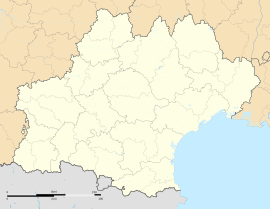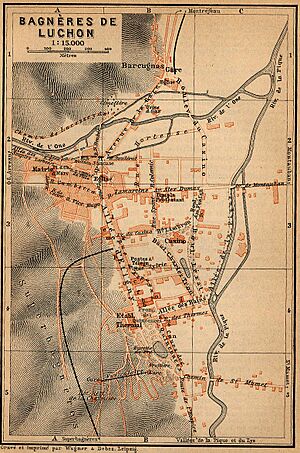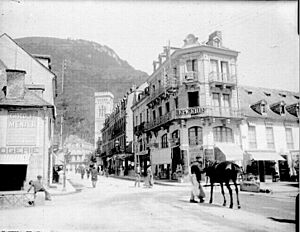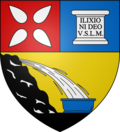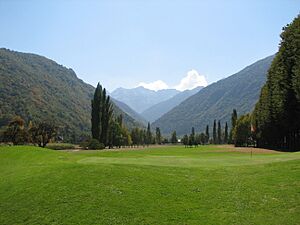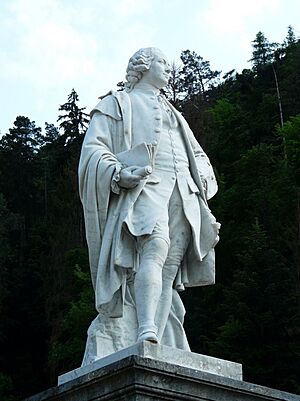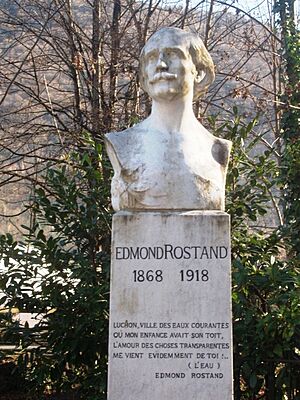Bagnères-de-Luchon facts for kids
Quick facts for kids
Bagnères-de-Luchon
Banhèras de Luishon (Occitan)
|
||
|---|---|---|
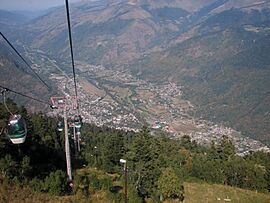
The Luchon Valley from the Cable Car
|
||
|
||
| Country | France | |
| Region | Occitanie | |
| Department | Haute-Garonne | |
| Arrondissement | Saint-Gaudens | |
| Canton | Bagnères-de-Luchon | |
| Area
1
|
52.80 km2 (20.39 sq mi) | |
| Population
(2021)
|
2,152 | |
| • Density | 40.758/km2 (105.56/sq mi) | |
| Time zone | UTC+01:00 (CET) | |
| • Summer (DST) | UTC+02:00 (CEST) | |
| INSEE/Postal code |
31042 /31110
|
|
| Elevation | 611–2,737 m (2,005–8,980 ft) (avg. 630 m or 2,070 ft) |
|
| 1 French Land Register data, which excludes lakes, ponds, glaciers > 1 km2 (0.386 sq mi or 247 acres) and river estuaries. | ||
Bagnères-de-Luchon is a lovely town in the Haute-Garonne area of south-western France. People often call it just Luchon. It's famous as a spa town, meaning it has special natural hot springs.
The town has even won "three flowers" from a national group that celebrates beautiful towns and villages. This shows how pretty and well-kept Luchon is!
Contents
Geography: Where is Luchon?
Bagnères-de-Luchon is right near the border with Spain. It's about 50 kilometers (31 miles) southwest of Saint-Gaudens. The town sits in a valley at the bottom of the Pyrenees mountains. These mountains form a natural wall to the south, so you can't cross into Spain directly from here.
The town is located where two rivers meet: the L'One from the west and the Pique from the south. Many smaller streams flow into these rivers. There are also some high mountain lakes in the south that feed the Pique river.
How to Get Around Luchon
Luchon has a railway station, but train services to Montréjeau and Toulouse stopped in 2014. Now, you can take a bus instead.
Since 1993, a Gondola lift connects Bagnères-de-Luchon to Superbagnères. This gondola replaced an old mountain railway that ran from 1912 to 1966. It's a fun way to get up the mountain!
There's also a small airport near the town. It's home to the Aeroclub de Luchon, where people can enjoy flying.
Luchon's Weather
Luchon's location on a slope helps keep its climate a bit drier. In winter, temperatures can range from -10 to 10 degrees Celsius (14 to 50 degrees Fahrenheit). Summer temperatures are usually between 10 and 35 degrees Celsius (50 to 95 degrees Fahrenheit). Winds from the north often bring clear, sunny weather. Winds from the southwest or northwest usually mean rain or snow is coming. Sometimes, strong storms with hail can happen when warm, moist air from the south meets dry air from the north.
| Climate data for Luchon (altitude 618 m, 1991–2020 normals, extremes 1994–present) | |||||||||||||
|---|---|---|---|---|---|---|---|---|---|---|---|---|---|
| Month | Jan | Feb | Mar | Apr | May | Jun | Jul | Aug | Sep | Oct | Nov | Dec | Year |
| Record high °C (°F) | 23.5 (74.3) |
25.5 (77.9) |
26.2 (79.2) |
30.2 (86.4) |
35.3 (95.5) |
39.6 (103.3) |
38.0 (100.4) |
38.9 (102.0) |
35.7 (96.3) |
31.1 (88.0) |
26.4 (79.5) |
25.7 (78.3) |
39.6 (103.3) |
| Mean daily maximum °C (°F) | 10.1 (50.2) |
11.4 (52.5) |
14.5 (58.1) |
16.6 (61.9) |
19.6 (67.3) |
23.0 (73.4) |
25.0 (77.0) |
25.4 (77.7) |
22.2 (72.0) |
19.3 (66.7) |
13.5 (56.3) |
10.6 (51.1) |
17.6 (63.7) |
| Daily mean °C (°F) | 4.2 (39.6) |
5.1 (41.2) |
8.1 (46.6) |
10.5 (50.9) |
13.9 (57.0) |
17.3 (63.1) |
19.2 (66.6) |
19.2 (66.6) |
15.9 (60.6) |
12.9 (55.2) |
7.5 (45.5) |
4.7 (40.5) |
11.5 (52.7) |
| Mean daily minimum °C (°F) | −1.6 (29.1) |
−1.1 (30.0) |
1.7 (35.1) |
4.5 (40.1) |
8.1 (46.6) |
11.5 (52.7) |
13.4 (56.1) |
13.0 (55.4) |
9.6 (49.3) |
6.5 (43.7) |
1.6 (34.9) |
−1.2 (29.8) |
5.5 (41.9) |
| Record low °C (°F) | −15.9 (3.4) |
−17.2 (1.0) |
−14.6 (5.7) |
−3.9 (25.0) |
−2.1 (28.2) |
2.0 (35.6) |
4.9 (40.8) |
4.5 (40.1) |
0.1 (32.2) |
−5.7 (21.7) |
−10.1 (13.8) |
−13.6 (7.5) |
−17.2 (1.0) |
| Average precipitation mm (inches) | 99.7 (3.93) |
76.9 (3.03) |
75.5 (2.97) |
91.2 (3.59) |
100.6 (3.96) |
71.6 (2.82) |
63.7 (2.51) |
54.9 (2.16) |
58.2 (2.29) |
65.3 (2.57) |
106.1 (4.18) |
76.8 (3.02) |
940.5 (37.03) |
| Average precipitation days (≥ 1.0 mm) | 10.8 | 9.4 | 10.3 | 12.1 | 12.0 | 9.4 | 7.7 | 7.9 | 8.4 | 9.1 | 11.1 | 9.7 | 117.8 |
| Source: Météo-France | |||||||||||||
 |
Cazaril-Laspènes | Moustajon | Sode |  |
| Saint-Aventin | Saint-Mamet | |||
| Benasque (Spain) | Spain |
Toponymy: What's in a Name?
The name Bagnères-de-Luchon tells us two things about the town. "Bagnères" comes from the French word for "baths," referring to its famous hot springs. "Luchon" comes from "Lixon" or "Illixon," the name of a local ancient god.
Experts have confirmed that "Lixon" is the correct Roman name for Luchon.
History: A Look Back in Time
People have lived in the Luchon area for over 2,000 years! We know this from ancient tools found in caves and Stone circles.
The town became important during Roman times. Around 25 BC, a Roman leader named Tiberius Claude built three pools and developed the thermal baths. The baths had a proud motto: "Balneum Lixonense post Neapolitense primum," meaning "the Luchon baths are the best after those of Naples." This is still the town's motto today!
Over the centuries, different groups passed through the region. People often hid in the high valleys during invasions.
In 987, the village of "Banières" and its baths were already well-known. A big fair was held there every year.
Around 1200, the Knights Hospitaller built a place called a "commandery" nearby. Their goal was to help pilgrims and traders who traveled through the mountains. The Hospice de France building is the only remaining trace of these knights.
For a long time, the people of the Pyrenees had special agreements called Lies et passeries. These allowed people on both sides of the mountains to move freely and trade, even if their countries were at war. This helped them survive. Local elected leaders called "consuls" also gave the people a voice.
In 1759, a man named Baron Antoine Mégret d'Étigny was sent to Luchon. He worked hard to improve the town. He built a better road and made the baths even more popular. Famous people like Marshal Duke of Richelieu started visiting. The spa became very fashionable! The Baron also helped develop the local forests.
Many famous visitors came to Luchon over the years, drawn by the popular thermal waters. These included writers like Lamartine and Gustave Flaubert, and even royalty like Napoleon III.
When the railway arrived in 1873 and a casino was built in 1880, Luchon became even more popular. Rich tourists from all over the world came to visit. Later, as more people got paid time off work, tourism became popular for everyone.
Luchon has also been a regular stop for the Tour de France cycling race since it began.
The mountain hotel of Superbagnères opened in 1922. It became a winter sports resort, connected to Luchon by a special railway, and now by the gondola.
Luchon is sometimes called the "Queen of the Pyrenees." Its mineral water has been sold all over France.
In 2010, a big storm called Cyclone Xynthia hit Luchon. It caused a lot of damage with winds up to 200 kilometers per hour (124 mph).
Heraldry: Luchon's Coat of Arms
| Blazon: The coat of arms shows a black mountain with a stream of water flowing into a blue bath. On the top left, there are four silver shapes on a red background. On the top right, there is a blue background with an ancient altar that says "ILIXIONI DEO V.S.L.M." in black letters. |
Administration: How Luchon is Run
Luchon is led by a mayor. The current mayor is Éric Azémar, who has been in office since 2020.
Twin Towns: Friends Around the World
Bagnères-de-Luchon has special "twinning" partnerships with other towns. This means they share culture and friendship. Luchon is twinned with:
 Harrogate in the United Kingdom (since 1953).
Harrogate in the United Kingdom (since 1953). Sitges in Spain (since 1981).
Sitges in Spain (since 1981). Benasque in Spain (since 1990).
Benasque in Spain (since 1990). Vielha in Spain (since 1990).
Vielha in Spain (since 1990).
Demography: Who Lives in Luchon?
The people who live in Bagnères-de-Luchon are called Luchonnais (for men) or Luchonnaises (for women).
| Historical population | |||||||||||||||||||||||||||||||||||||||||||||||||||||||||||||||||||||||||||||||||||||||||||||||||||||||||||||||||||
|---|---|---|---|---|---|---|---|---|---|---|---|---|---|---|---|---|---|---|---|---|---|---|---|---|---|---|---|---|---|---|---|---|---|---|---|---|---|---|---|---|---|---|---|---|---|---|---|---|---|---|---|---|---|---|---|---|---|---|---|---|---|---|---|---|---|---|---|---|---|---|---|---|---|---|---|---|---|---|---|---|---|---|---|---|---|---|---|---|---|---|---|---|---|---|---|---|---|---|---|---|---|---|---|---|---|---|---|---|---|---|---|---|---|---|---|
|
|
||||||||||||||||||||||||||||||||||||||||||||||||||||||||||||||||||||||||||||||||||||||||||||||||||||||||||||||||||
| Source: EHESS and INSEE | |||||||||||||||||||||||||||||||||||||||||||||||||||||||||||||||||||||||||||||||||||||||||||||||||||||||||||||||||||
Economy: What Does Luchon Do?
Luchon's economy relies on a few key things:
- Hydrotherapy: This means the spa baths and treatments.
- Winter sports: Especially at Superbagnères.
- Mineral water: The natural spring water.
- Tourism: People visiting for holidays and activities.
Culture and Heritage: Things to See and Do
Civil Heritage: Historic Buildings
Luchon has many old and beautiful buildings. Some of these are protected as historical monuments:
- The Villa Pyrène (from the 19th century)
- The Villa Luisa (built in 1884)
- The Villa Edouard (from 1864)
- The Château Lafont (from the 18th century), which is now a museum.
- The Chalets Spont (from the 19th century)
- The Charles Tron Residence (built in 1854)
- The Villa Santa Maria (from 1840)
- The Chambert Thermal Baths (from 1854). These baths even have ancient Roman artifacts!
- The Casino (built in 1878). It has a beautiful park with a winding pond and a fake cave.
- Ancient Stone circles and Stone rows from the Neolithic period (Stone Age).
Religious Heritage: Churches and Chapels
There are also several historic religious buildings:
- The Chapel of Saint Étienne (from the 12th century). It has a very old statuette of the Virgin Mary and child.
- The Church of Our Lady of the Assumption (built in 1847). It's built in a Romanesque Revival style and has beautiful murals. It also has a chalice from the 17th century and a bell from 1596!
- Religious heritage picture gallery
Thermal Springs: The Famous Baths
Bagnères-de-Luchon is famous for its thermal springs. There are 48 different springs! Their water has different minerals, mostly sodium sulphate, and they range in temperature from 17°C to 65°C (63°F to 149°F). We know these baths were used in Roman times because many Roman remains have been found here.
Today, the baths have a modern entrance. The bathing experience often involves spending time in hot, steamy caves that go about 100 meters (328 feet) inside the Superbagnères mountain. Then, you can cool off in a swimming pool. These sulfur springs are why Luchon is twinned with Harrogate in the UK.
Luchon is a popular and stylish resort. The most famous street is the Allées d'Étigny, which is lined with lime trees, bars, and restaurants. At the end of this street is the main thermal bath building.
- Thermal Baths Picture Gallery
Cultural Events and Festivities
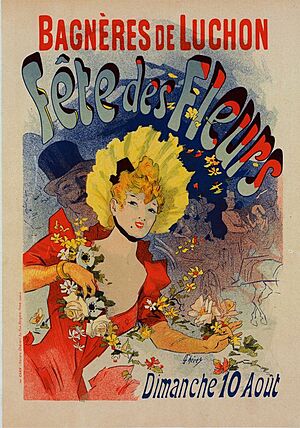
Luchon hosts several fun events:
- The Luchon Television Film Festival
- The Festival of Flowers
- The Rencontres lyriques de Luchon (a Music Festival)
Luchon in Books and Movies
Bagnères-de-Luchon is mentioned in some famous stories:
- It appears briefly in the ghost story "Cannon Alberic's Scrap-Book" by M.R. James (1904).
- It's the setting for an early part of François Mauriac's novel Le Noeud de Vipères (1932).
- The town is also the setting for the 2018 film Things Fall Where They Lie.
Sports and Activities
Superbagnères is a ski resort located near Luchon. You can only reach it from Bagnères-de-Luchon, usually by the gondola lift. The gondola ride takes about ten minutes and can carry up to four people. It runs in both summer and winter.
Cycling is very popular in the Luchon area, especially in summer. There are many challenging mountain climbs nearby, like Superbagnères and Col de Peyresourde.
Bagnères-de-Luchon has been a regular stop for the famous Tour de France cycling race since 1910.
Luchon is also a great place for mountain biking. Its location in a valley means there are many routes into the mountains. You can even take your bike on the gondola!
Other sports you can enjoy in Luchon include:
- A nine-hole golf course, one of the oldest in the area.
- Tandem paragliding from Superbagnères.
- Tennis courts.
- An aerodrome for gliding.
Notable People Linked to Luchon
Many interesting people have connections to Bagnères-de-Luchon:
- Antoine Mégret d'Étigny (1719–1767): He was a key figure in developing Luchon's baths and roads. The main street in town, the Allées d'Étigny, is named after him, and there's a statue of him.
- Nérée Boubée (1806–1862): A naturalist who studied insects, geology, and taught at the University of Paris. He passed away in Luchon.
- Théodore Gobley (1811–1876): A pharmacist and chemist who made important discoveries about fats. He died in Luchon.
- Stéphen Liégeard (1830–1925): A French writer and poet who wrote about his travels in the Luchon area.
- Jean-Marie Mengue (1855–1939): A sculptor who was born in Bagnères-de-Luchon.
- Henry de Gorsse (1868–1936): A writer and playwright born in Luchon.
- Edmond Rostand (1868–1918): A famous playwright, known for Cyrano de Bergerac. He spent many summers in Luchon as a young man, and the area inspired his writing.
- Jules Brévié (1880–1964): A colonial administrator and minister, born in Bagnères-de-Luchon.
- Georges Lucien Guyot (1885–1973): An artist known for his wildlife art. His sculpture "Bear of the Pyrénées" is in the Thermal Baths grounds.
- Lys Gauty (1908–1994): A singer who managed the Luchon Casino and started a music festival there.
- Michel Warlop (1911–1947): A jazz violinist who died in Luchon.
- Guy Lapébie (1916–2010): A racing cyclist who died in Luchon.
- Alexis Kanner (1942–2003): An Anglo-Canadian actor born in Bagnères-de-Luchon.
- Britt Lafforgue and Ingrid Lafforgue (born 1948): Twin sisters and ski champions, both born in Bagnères-de-Luchon.
- Nicole Peyrafitte (born 1960): A multi-talented artist born in Luchon.
See also
 In Spanish: Bañeras de Luchón para niños
In Spanish: Bañeras de Luchón para niños




